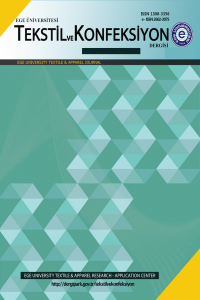KALANDIRLAMA VE DİNKLEME İŞLEMİNİN TAKIM ELBİSELİK KUMAŞLARIN GİYSİ KONFORU ÖZELLİKLERİNE ETKİSİ
Takım elbiselik kumaş, Kalandırlama işlemi, Dinkleme işlemi, Isıl konfor, Yüzey özellikleri
EFFECTS OF CALENDERING AND MILLING PROCESSES ON CLOTHING COMFORT PROPERTIES OF SUIT FABRICS
___
- 1. Milenkovic, L., Skundric, P., Sokolovic, R. and Nikolic, T., 1999, “Comfort properties of defence protective clothing”, The Scientific Journal FactaUniversitatis, Vol.: 4, pp:101-106.
- 2. Jun Y., Kang K. Y., Park C. and Choi C., 2002, “Evaluation of textile performance of soccer wear”, Textile Asia, 5(33), pp:43-44.
- 3. Wang G., Zhang W., Postle R. and Phillips D., 2003, “Evaluating wool shirt comfort with wear trials and the forearm test”, Textile Research Journal, 2(73), pp:113-119.
- 4. Zhou L., Feng X., Du Y. and Li Y., 2007, “Characterization of liquid moisture transport performance of wool knitted fabrics”, Textile Research Journal, 12(77), pp:951-956.
- 5. Marmaralı A., Kadoğlu H., Oğlakcıoğlu N., Çelik P. veÜte T. B., 2008, “A research on properties of natural colored cotton/Angora rabbit fiber blended yarns and their effects on thermal comfort properties of knitted fabrics”, Tekstil ve Konfeksiyon, 3(18), pp:191-197.
- 6. Blaga N., Marmaralı A. and Mihai A., 2009, “High comfort knitted fabrics for linings of orthopaedics footwear”, The 6th International Conference Management of Technological Changes.
- 7. Bilen U. and Kırtay E., 2010, “The thermal properties of alpaca/wool blended fabrics”, Fiber Society Spring International Conference on Fibrous Materials, pp:137-138.
- 8. Nergis B. U., Candan C. and Küçükali M., 2010, “A study on moisture related properties of wool/acrylic blend fabrics”, Fiber Society Spring International Conference on Fibrous Materials, pp:147-148.
- 9. Majumdar A., Mukhopadhyay S. and Yadav R., 2010, “Thermal properties of knitted fabrics made from cotton and regenerated bamboo cellulosic fibres”, International Journal of Thermal Sciences, 49 (10), pp:2042-2048.
- 10. Abdel-Fattah S. H. and El-Katib E. M., 2007, “Improvement of pilling properties of polyester/wool blended fabrics”, Journal of Applied Sciences Research, 3(10), pp:1206-1209.
- 11. Bajzik V. and Hes L.,2012, “The effect of finishing treatment on thermal insulation and thermal contact properties of wet fabrics”, Tekstil ve Konfeksiyon, Vol: 1, pp:26-31.
- 12. Macsim M., Butnaru R. and Penciuc M., 2011, “The influence of dyeing process conditions on structural parameters of cotton knitted fabrics”, Tekstil ve Konfeksiyon, Vol: 3, pp:257-264.
- 13. Tyagi G. K., Krishna G., Bhattacharya S. and Kumar P., 2009, “Comfort aspects of finished polyester-cotton and polyester-viscose ring and MJS yarn fabrics”, Indian Journal of Fibre& Textile Research, Vol: 34, pp. 137-143.
- 14. Akcakoca K. P., Marmarali A. and Oglakcioglu N., “Finishing treatment effects on thermal comfort properties of three-yarn fleece fabrics”, AATCC Review: the magazine of the textile dyeing, printing, and finishing industry, Vol. 11, No. 4, 2011, pp. 46-51.
- 15. Marmaralı A., Kretzschmar D. S., Özdil N. and Oğlakcıoğlu N., 2006, “Parameters that affect thermal comfort of garment”, Tekstil ve Konfeksiyon, Vol: 16, No:4, pp. 241-246.
- 16. Candan C., “Factors affecting the pilling performance of knitted wool fabrics”, 2010, Engineering Environmental Science, Vol:24, pp. 35-44.
- 17. Lima M, Hes L, Vasconcelos R and Martins J, 2005, “Frictorq, accessing fabric friction with novel fabric surface tester”, Autex Research Journal, Vol.5, No 4, pp. 194-201.
- 18. Du Z, Zhou T, Yan N, Hua S and Yu W, 2011, “Measurement and characterization of bending stiffness for fabrics”, Fibers and Polymers, Vol.12, No.1, pp. 104-110
- ISSN: 1300-3356
- Yayın Aralığı: Yılda 4 Sayı
- Başlangıç: 1991
- Yayıncı: Ege Üniversitesi
Kürşat ÖNCÜL, M. Çetin ERDOĞAN, Mustafa GÜNEŞ
HESAPLAMALI AKIŞKANLAR DİNAMİĞİ YARDIMIYLA ÖRME KUMAŞLARIN HAVA GEÇİRGENLİĞİNİN TAHMİN EDİLMESİ
Serin MEZARCIÖZ, Serkan MEZARCIÖZ, R.tuğrul OĞULATA
Kenan YILDIRIM, A. Melek KÖSTEM, Nurcan AYDIN, Hüseyin TUNA, Ayhan CENAN
METOT ANALİZİNİN ÜRETİM HACMİ VE MONTAJ HATTI VERİMLİLİĞİNE ETKİSİNİN ARAŞTIRILMASI
FARKLI YUMUŞATMA FORMÜLASYONLARI KULLANARAK ÇARŞAF ISIL KONFOR ÖZELLİKLERİNİN OPTİMİZASYONU
Maria Jose ABREU, Candida VIDRAGO, Graça Maria SOARES
TUZLU SUYA MARUZ KALAN NOMEX KUMAŞLARIN ISIL İLETKENLİĞİ VE DİRENCİ
Monika BOGUSLAWSKA –BACZEK, Lubos HES
TÜRK HAZIR GİYİM SEKTÖRÜNDE HIZLI MODA VE HIZLI MODA PERAKENDECİLİĞİ ÜZERİNE BİR İNCELEME
Yasemin HACIOLA, Turan ATILGAN
Nilgün ÖZDİL, Arif Taner ÖZGÜNEY, Gamze SÜPÜREN MENGÜÇ, Sima SERTSÖZ
